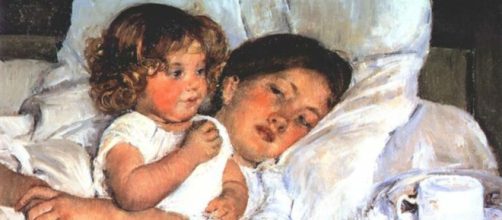What do you call Old Masters who were women – Old Mistresses? An art museum in Madrid, Spain calls them Women Masters.
The Museo Nacional Thyssen-Bornemisza has mounted a show by women “curated from a feminist perspective” of nearly 100 artworks – paintings, sculptures and works on paper – dating between the 16th and 20th centuries.
All the usual suspects are here: Artemisia Gentileschi, Angelica Kauffmann, Clara Peeters, Rosa Bonheur, Mary Cassatt, Berthe Morisot and Sonia Delaunay. Too many to talk about.
The 'alternative gaze'
But when it comes to what the museum calls the “alternative gaze” to describe the exhibit, Mary Cassatt’s example “Breakfast in Bed” unintentionally explains everything.
Granted, when we think of Cassatt, issues of feminism don’t fit the picture. She painted so many scenes of domesticity, of mothers and children, they flood the mind. But a close look at “Breakfast in Bed” tells a different story.
While you see a woman lying in bed with her arm wound tightly around her small child, they are not as bound as they appear. The child is very much in the present, chomping on her breakfast food, but the mother, staring off into space, is not present.
Despite the embrace, then, Cassatt makes clear the divide between mother and child by picturing the woman looking away. She has something on her mind, Cassatt seems to be saying, that has nothing to do with her child.
Too much of a leap?
Not if you know Cassatt’s story, which was acted out in the memorable 1999 biopic “Mary Cassatt: An American Impressionist” starring Amy Brenneman as the painter.
The film demonstrates Cassatt’s disdain for marriage and children. To keep herself at a safe remove from family life, she left her socialite lifestyle in Philadelphia to paint in Paris.
Not even wanting to see domesticity practiced by others, Cassatt was put off when her brother and his children came to visit her. She even tried to influence her teenage niece to think of an occupation rather than marriage.
The family life didn’t interfere with my life as a painter. I never minded my children underfoot when I was at my easel. But that doesn’t make me a better person than Cassatt.
I live in a different time when even the artist who trained me, Robert Motherwell, was married to a painter (Helen Frankenthaler).
The big flaw in this movie is that it doesn't explain why Cassatt avoided marriage and family. You hear her saying only that she'd worry a husband's adoration would cloud her critical faculties.
Sign of the times
Missing from the film is the blatant sexism in Cassatt’s time, discouraging women from making art. She even got slings and arrows from her closest friend in Paris, Edgar Degas.
Art historian Phoebe Pool quoted Degas in her 1967 book “Impressionism” saying that “in women, there is an absence of all feeling in the presence of art.” If an artist friend could say that, what could she expect from a husband?
Not that sexism came only from male artists. The painter May Alcott wrote to her sister Louisa May Alcott about Cassatt this way: "Her paintings are handled in a masterly way, with a touch of strength one seldom finds coming from a woman's fingers."
Did she never see Gentileschi’s “Judith Slaying Holofernes”?


